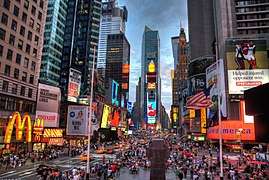Chelsea, Manhattan
| Chelsea | |
|---|---|
| Neighborhood of Manhattan | |
|
A Chelsea streetscape | |
 Chelsea Location  Chelsea Chelsea (New York)  Chelsea Chelsea (the US) | |
| Coordinates: 40°44′43″N 74°0′8″W / 40.74528°N 74.00222°WCoordinates: 40°44′43″N 74°0′8″W / 40.74528°N 74.00222°W | |
| Country |
|
| State |
|
| City |
|
| Borough | Manhattan |
| Area | |
| • Total | 0.774 sq mi (2.00 km2) |
| • Land | 0.774 sq mi (2.00 km2) |
| • Water | 0 sq mi (0 km2) 0% |
| Population | |
| • Total | 38,242 |
| • Density | 49,000/sq mi (19,000/km2) |
| 2010 figures | |
| ZIP Codes | 10001, 10011 |
| Area code(s) | 212, 332, 646, and 917 |
|
Chelsea Historic District | |
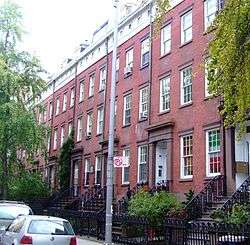 The Cushman Row, 406-418 W. 20th St., dates from 1840 | |
| Location |
Roughly: West 19th – West 23rd Streets Eighth –Tenth Avenues[lower-alpha 1] |
| Coordinates | 40°44′43″N 74°0′8″W / 40.74528°N 74.00222°W |
| Built | 1830 |
| Architect | Multiple |
| Architectural style | Greek Revival, Italianate, Georgian |
| NRHP reference # |
77000954 (original) 82001190 (increase)[1] |
| Significant dates | |
| Added to NRHP |
December 6, 1977 (original) December 16, 1982 (increase) |
| Designated NYCL |
September 15, 1970 February 3, 1981 (extension) |
Chelsea is a neighborhood on the West Side of the borough of Manhattan in New York City. The district's boundaries are roughly 14th Street to the south, the Hudson River and West Street to the west, and Sixth Avenue to the east, with its northern boundary variously described as near the upper 20s[2][3] or 34th Street, the next major crosstown street to the north.[4][5]
To the northwest of Chelsea is the neighborhood of Hell's Kitchen, as well as Hudson Yards; to the northeast are the Garment District and the remainder of Midtown South; to the east are NoMad and the Flatiron District; to the southwest is the Meatpacking District; and to the south and southeast are the West Village and the remainder of Greenwich Village.[6][lower-alpha 2]
Chelsea is part of Manhattan Community Board 4.[7] contains the Chelsea Historic District and its extension, which were designated by the New York City Landmarks Preservation Commission in 1970 and 1981 respectively.[8] The district was added to the National Register of Historic Places in 1977, and expanded in 1982 to include contiguous blocks containing particularly significant examples of period architecture.
The neighborhood is primarily residential, with a mix of tenements, apartment blocks, city housing projects, townhouses, and renovated rowhouses, but its many retail businesses reflect the ethnic and social diversity of the population. The area has a large LGBTQ population.[9] Chelsea is also known as one of the centers of the city's art world, with over 200 galleries in the neighborhood. As of 2015, due to the area's gentrification, there is a widening income gap between the wealthy living in luxury buildings and the poor living in housing projects, who are, at times, across the street from each other.
History
Early development
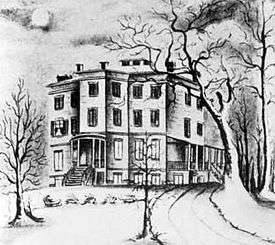
Chelsea takes its name from the estate and Georgian-style house of retired British Major Thomas Clarke, who obtained the property when he bought the farm of Jacob Somerindyck on August 16, 1750. The land was bounded by what would become 21st and 24th Streets, from the Hudson River to Eighth Avenue.[3] Clarke chose the name "Chelsea" after the Royal Hospital Chelsea, a retirement home for soldiers in London, England.[10][11] Clarke passed the estate on to his daughter, Charity, who, with her husband Benjamin Moore, added land on the south of the estate, extending it to 19th Street.[3] The house was the birthplace of their son, Clement Clarke Moore, who in turn inherited the property. Moore is generally credited with writing "A Visit From St. Nicholas" and was the author of the first Greek and Hebrew lexicons printed in the United States.
In 1827, Moore gave the land of his apple orchard to the Episcopal Diocese of New York for the General Theological Seminary, which built its brownstone Gothic, tree-shaded campus south of the manor house. Despite his objections to the Commissioner's Plan of 1811, which ran the new Ninth Avenue through the middle of his estate, Moore began the development of Chelsea with the help of James N. Wells, dividing it up into lots along Ninth Avenue and selling them to well-heeled New Yorkers.[12] Covenants in the deeds of sale specified what could be built on the land – stables, manufacturing and commercial uses were forbidden – as well as architectural details of the buildings.[3]
Industrialization
The new neighborhood thrived for three decades, with many single family homes and rowhouses, in the process expanding past the original boundaries of Clarke's estate, but an industrial zone also began to develop along the Hudson.[3] In 1847 the Hudson River Railroad laid its freight tracks up a right-of-way between Tenth and Eleventh Avenues, separating Chelsea from the Hudson River waterfront. By the time of the Civil War, the area west of Ninth Avenue and below 20th Street was the location of numerous distilleries making turpentine and camphene, a lamp fuel. In addition, the huge Manhattan Gas Works complex, which converted bituminous coal into gas, was located at Ninth and 18th Street.[13]
The industrialization of western Chelsea brought immigrant populations from many countries to work in the factories,[14] including a large number of Irish immigrants, who dominated work on the Hudson River piers that lined the nearby waterfront and the truck terminals integrated with the freight railroad spur.[lower-alpha 3] As well as the piers, warehouses and factories, the industrial area west of Tenth Avenue also included lumberyards and breweries, and tenements built to house the workers. With the immigrant population came the political domination of the neighborhood by the Tammany Hall machine,[14] as well as festering ethnic tensions: around 67 people died in a riot between Irish Catholics and Irish Protestants on July 12, 1871, which took place around 24th Street and Eighth Avenue.[3][15] The social problems of the area's workers provoked John Lovejoy Elliot to form the Hudson Guild in 1897, one of the first settlement houses – private organizations designed to provide social services.
Recent history
_-_10.jpg)
A theater district had formed in the area by 1869,[3] and soon West 23rd Street was the center of American theater, led by Pike's Opera House (1868, demolished 1960), on the northwest corner of Eighth Avenue. Chelsea was an early center for the motion picture industry before World War I. Some of Mary Pickford's first pictures were made on the top floors of an armory building at 221 West 26th Street, while other studios were located on 23rd and 21st Streets.[14]
London Terrace was one of the world's largest apartment blocks when it opened in 1930, with a swimming pool, solarium, gymnasium, and doormen dressed as London bobbies. Other major housing complexes in the Chelsea area are Penn South, a 1962 cooperative housing development sponsored by the International Ladies Garment Workers' Union, and the New York City Housing Authority-built and -operated Fulton Houses and Chelsea-Elliot Houses.
The massive 23-story Art Deco Walker Building, which spans the block between 17th and 18th Streets just off of Seventh Avenue, was built in the early 1930s. It typifies the real estate activity of the district, as it has been converted in 2012 to residential apartments on the top 16 floors, with Verizon retaining the lower seven floors.[16]
In the early 1940s, tons of uranium for the Manhattan Project were stored in the Baker & Williams Warehouse at 513-519 West 20th Street. The uranium was removed and a decontamination project at the site was completed early 1990s.[17]
On September 17, 2016, there was an explosion outside a building on 23rd Street, which injured 29 people; police located and removed a second, undetonated pressure cooker bomb on 27th Street.[18][19] A suspect, Ahmad Khan Rahami, was captured two days later after a gunfight in Linden, New Jersey.[20]
Culture
People of many different cultures live in Chelsea. Chelsea is famous for having a large LGBTQ population, with one of Chelsea's census tracts reporting that 22% of its residents were gay couples,[9] and is known for its social diversity and inclusion.[21] Eighth Avenue is a center for LGBT-oriented shopping and dining, and from 16th to 22nd Streets between Ninth and Tenth Avenues, mid-nineteenth-century brick and brownstone townhouses are still occupied, a few even restored to single family use.[22][23]
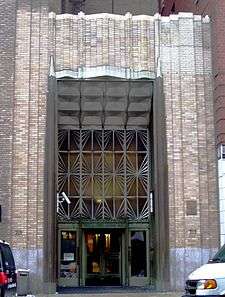
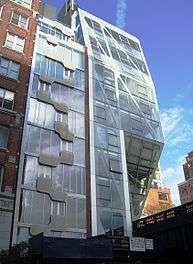
The stores of Chelsea reflect the ethnic and social diversity of the area's population. Ethnic restaurants, delis, and clothing boutiques are plentiful. The Chelsea Lofts district – the former fur and flower district – is located roughly between Sixth and Seventh Avenues from 23rd to 30th streets. The McBurney YMCA on West 23rd Street, commemorated in the hit Village People song Y.M.C.A., sold its home and relocated in 2002 to a new facility on 14th Street, the neighborhood's southern border.[24]
Most recently, Chelsea has become an alternative shopping destination, starring the likes of Barneys CO-OP — which replaced the much larger original Barneys flagship store — Comme des Garçons, Balenciaga boutiques, Alexander McQueen, Stella McCartney, and Christian Louboutin. Chelsea Market, on the ground floor of the former Nabisco Building, is a destination for food lovers. In the late 1990s, New York's visual arts community began a gradual transition away from SoHo, due to increasing rents and competition from upscale retailers for the large and airy spaces that art galleries require,[25] and the area of West Chelsea between Tenth and Eleventh Avenues and 16th and 28th Streets has become a new global centers of contemporary art, home to over 200 art galleries that are home to modern art from both upcoming and established artists.[26] Along with the art galleries, Chelsea is home to the Rubin Museum of Art, with a focus on Himalayan art; the Graffiti Research Lab and New York Live Arts, a producing and presenting organization of dance and other movement-based arts. The community, in fact, is home to many highly regarded performance venues, among them the Joyce Theater, one of the city's premier modern dance emporiums, and The Kitchen, a center for cutting-edge theatrical and visual arts.
Above 23rd Street, by the Hudson River, the neighborhood is post-industrial, featuring the elevated High Line viaduct, which follows the river all through Chelsea. The elevated rail line was the successor to the street-level freight line original built through Chelsea in 1847, which was the cause of numerous fatal accidents, so it was elevated in the early 1930s by the New York Central Railroad. It fell out of use in the 1960s through 1980 and was originally slated to be torn down, but in the early 2000s, it was redesigned and converted into a highly used aerial greenway and rails-to-trails park. [27] With a change in zoning resolution in conjunction with the development of the High Line, Chelsea experienced a new construction boom, with projects by notable architects such as Shigeru Ban, Neil Denari, Jean Nouvel, and Frank Gehry. The neighborhood was quickly gentrifying, with small businesses being replaced by big-box retailers and technology and fashion stores.[5] With this development, more wealthy residents moved in, further widening an already-existing income gap with public-housing residents. In 2015, the average yearly household income in most of Chelsea was about $140,000. On the other hand, in the area's two public-housing developments – the Chelsea-Elliot Houses, between 25th Street, Ninth Avenue, 28th Street, and Tenth Avenue; and Fulton Houses, between 16th Street, Ninth Avenue, 19th Street, and Tenth Avenue – the average income was less than $30,000.[5] At the same time, the area's Puerto Rican enclaves and rent-subsidized housing, especially in Penn South, was being replaced by high-rent studios. This resulted in large income disparities across the neighborhood; one block in particular – 25th Street between 9th and 10th Avenues – had the Elliot Houses on its north side and two million-dollar residences on its south side.[5]
The Chelsea neighborhood is served by two weekly newspapers: the Chelsea-Clinton News and Chelsea Now.
West Chelsea refers to the western portion of Chelsea, much of which was previously a manufacturing area and has since been rezoned to allow for high-rise residential uses. It is often considered the area of Chelsea between the Hudson River to the west and Tenth Avenue to the east, a portion of which was designated a a historic district in 2008.[28] A 2008 article in The New York Times showed the eastern boundary of West Chelsea as Eighth Avenue for the area between 14th and 23rd streets, Ninth Avenue between 23rd and 25th, and Tenth Avenue between 25th and 29th.[29][30]
Landmarks and places of interest

Culinary
The Chelsea Market, located in a restored historic factory, is a festival marketplace that hosts a variety of shopping and dining options, including bakeries, a fish market, wine store, and many others.
The Empire Diner is a former art moderne diner designed by Fodero Dining Car Company. Built in 1946, it was altered in 1979 by Carl Laanes. Located at 210 Tenth Avenue at 22nd Street, it has been seen in several movies and mentioned in Billy Joel's song "Great Wall of China". The diner closed its doors for good on May 15, 2010, had a brief stint as "The Highliner", and most recently re-opened under its original name in January 2014[31] before closing permanently in December 2015 due to failures to pay rent.[32]
Peter McManus Cafe, a bar and restaurant on Seventh Avenue at 19th Street, is among the oldest family-owned and -operated bars in the city.
Cultural
Pike's Opera House was built in 1868, and bought the next year by James Fisk and Jay Gould, who renamed it the Grand Opera House. Located on the corner of Eighth Avenue and 23rd Street, it survived until 1960 as an RKO movie theater.[14]
The Irish Repertory Theatre is an Off-Broadway theatrical company on West 22nd St producing plays by Irish and Irish-American writers.
Joyce Theater, located in the former Elgin Theater at 175 Eighth Avenue, is in a 1941 movie house that closed in 1978. The Elgin was completely renovated to create in the Joyce a venue suitable for dance, and was reopened in 1982.[33]
The Kitchen is a performance space at 512 West 19th Street. it was founded in Greenwich Village in 1971 by Steina and Woody Vasulka, taking its name from the original location, the kitchen of the Mercer Arts Center.[34]
The warehouse building at 530 West 27th Street, which was the site of several notable megaclubs in the 1980s and 1990s, was acquired in 2011 by the British theater company Punchdrunk, who converted it into "The McKittrick Hotel", a five-story, 100,000-square-foot (9,300 m2) performance space housing their immersive site-specific theatrical production, Sleep No More. The building, along with those at 532 and 542 West 27th Street, is also the location of several restaurants and event venues that relate to the themes and stories told in the Hotel.[35][36]
New York Live Arts is a dance organization located at 219 West 19th Street between 7th and 8th Avenues.[37]
The Rubin Museum of Art is a museum dedicated to the collection, display, and preservation of the art of the Himalayas and surrounding regions, especially that of Tibet. It is located at 150 West 17th Street between the Avenue of the Americas (Sixth Avenue) and Seventh Avenue.

Industrial and commercial
The New York Office of Google occupies the full city block between 15th & 16th Streets, and from Eighth to Ninth Avenues. Located in 111 Eighth Avenue, the building was once Inland Terminal 1 of the Port Authority of New York and New Jersey.[38]
The Starrett-Lehigh Building, a huge full-block freight terminal and warehouse on West 26th Street between Eleventh and Twelfth Avenues, was built in 1930-1931 as a joint venture of the Starett real estate firm and the Lehigh Valley Railroad, and was engineered so that trains could pull directly into the ground floor of the building. Designed by Cory & Cory, the industrial behemoth was so architecturally notable that it was included in the Museum of Modern Art's 1932 "International Style" exhibition, one of only a few American buildings to be so honored. It was designated a New York City landmark in 1966.[8]
The Hudson Yards rail-yard development is located at the northern edge of Chelsea, within the Hudson Yards neighborhood. The project's centerpiece is a mixed-use real estate development by Related Companies. According to its master plan, created by master planner Kohn Pedersen Fox Associates, Hudson Yards is expected to consist of 16 skyscrapers containing more than 12,700,000 square feet (1,180,000 m2) of new office, residential, and retail space. Among its components will be six million square feet (560,000 m2) of commercial office space, a 750,000-square-foot (70,000 m2) retail center with two levels of restaurants, cafes, markets and bars, a hotel, a cultural space, about 5,000 residences, a 750-seat school, and 14 acres (5.7 ha) of public open space. The development, located mainly above and around the West Side Yard, will create a new neighborhood that overlaps with Chelsea and Hell's Kitchen.[39]
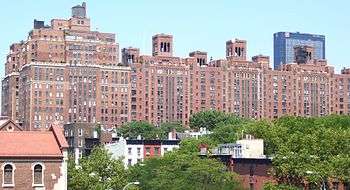
Residential
Hotel Chelsea, built 1883–1885 and designed by Hubert, Pirsson & Co., was New York's first cooperative apartment complex[8] and was the tallest building in the city until 1902. After the theater district migrated uptown and the neighborhood became commercialized, the residential building folded and in 1905 it was turned into a hotel.[40] The hotel attracted attention as the place where Dylan Thomas had been staying when he died in 1953 at St. Vincent's Hospital in Greenwich Village, and for the 1978 slaying of Nancy Spungen for which Sid Vicious was accused. The Hotel has been the home of numerous celebrities, including Brendan Behan, Thomas Wolfe, Mark Twain, Tennessee Williams and Virgil Thomson,[8] and the subject of books, films (Chelsea Girls, 1966) and music.
The London Terrace apartment complex on West 23rd was one of the world's largest apartment blocks when it opened in 1930, with a swimming pool, solarium, gymnasium, and doormen dressed as London bobbies. It was designed by Farrar and Watmough. It takes its name from the fashionable mid-19th century cottages which were once located there.[14]
Penn South is a large limited-equity housing cooperative constructed in 1962 by the United Housing Foundation and financed by the International Ladies' Garment Workers' Union. The development includes 2,820 apartments and covers six city blocks between 8th and 9th Avenue and 23rd and 29th Street. In 2012, there were 6,000 names on a waiting list of prospective residents looking to purchase a unit in the development.[41] Under the terms of agreements reached with the City of New York in 1986 and 2002, and separately with the United States Department of Housing and Urban Development, Penn South's eligibility for tax abatements offered by the Mitchell-Lama Housing Program has been extended to 2052.[42]
Other
The Chelsea Piers were the city's primary luxury ocean liner terminal from 1910 until 1935, when the growing size of ships made the complex inadequate. The RMS Titanic was headed to Pier 60 at the piers and the RMS Carpathia brought survivors to Pier 54 in the complex. The northern piers are now part of an entertainment and sports complex operated by Roland W. Betts, and the southern piers are part of Hudson River Park.[43] The park skirts the entire Hudson River waterfront from 59th Street to the Battery including most of the associated piers. It is being transformed into a joint city/state park with non-traditional uses.[44]
Chelsea Park is located between 9th and 10th Avenues, and between 27th and 28th Streets. It contains baseball diamonds, basketball courts and six handball courts.[45]
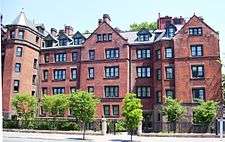
Chelsea Studios, a sound stage on 26th Street, has been operating since 1914, and numerous movies and television shows have been produced there.[46]
The Church of the Holy Apostles[47] was built in 1845–1848 to a design by Minard Lefever, with additions by Lefever in 1853–1854, and transepts by Charles Babcock added in 1858, this Italianate church was designated a New York City landmark in 1966 and is listed on the National Register of Historic Places. It is Lefever's only surviving building in Manhattan. The building, which featured an octagonal spire,[48] was burned in a serious fire in 1990, but stained glass windows by William Jay Bolton survived, and the church reopened in April 1994 after a major restoration.[8] The Episcopal parish is notable for hosting the city's largest program to feed the poor,[49] and is the second and larger home of the LGBT-oriented synagogue, Congregation Beth Simchat Torah.[50]
The General Theological Seminary of the Episcopal Church's college-like close is sometimes called "Chelsea Square." It consists of a city block of tree-shaded lawns between Ninth and Tenth Avenues and West 20th and 21st Streets. The campus is ringed by more than a dozen brick and brownstone buildings in Gothic Revival style. The oldest building on the campus dates from 1836. Most of the rest were designed as a group by architect Charles Coolidge Haight, under the guidance of the Dean, Augustus Hoffman.[51]
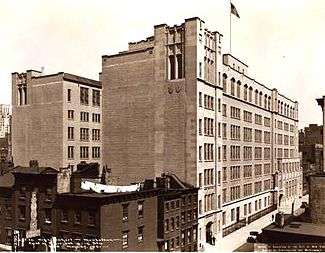
Education
There are numerous public schools in Chelsea, including Public School 11, also known as the William T. Harris School; P.S. 33, the Chelsea School; the O. Henry School (Intermediate School 70); Liberty High School For Newcomers; Lab School; the Museum School; and the Bayard Rustin Educational Complex, which houses six small schools.
The Bayard Rustin Educational Complex was founded as Textile High School in 1930, later renamed to Straubenmuller Textile High School, then Charles Evans Hughes High School. In the 1990s, it was renamed the Bayard Rustin High School for the Humanities after civil rights activist Bayard Rustin.[52] The high school closed in 2012 after a grading scandal, but the building had already started being used as a "vertical campus" housing multiple small schools. Quest to Learn, Hudson High School of Learning Technologies, Humanities Preparatory Academy, James Baldwin School, Landmark High School, and Manhattan Business Academy are the six constituent schools in the complex.
Private schools in the neighborhood include Avenues: The World School, a K-12 school; and the Catholic Xavier High School, a secondary school.
Chelsea is also home to the Fashion Institute of Technology, a specialized SUNY unit that serves as a training ground for the city's fashion and design industries. The School of Visual Arts, a for-profit art school and the public High School of Fashion Industries also have a presence in the design fields.
The neighborhood is also home to the General Theological Seminary of the Episcopal Church, the oldest seminary in the Anglican Communion. The Center for Jewish History, a consortium of several national research organizations, is a unified library, exhibition, conference, lecture, and performance venue, located on 16th Street between Fifth and Sixth Avenues.
Transportation
The neighborhood is reachable by the M7, M10, M11, M12, M14, M23 SBS New York City Bus routes. New York City Subway routes include the 1, 2, and 3 services on Seventh Avenue, the A, C, and E services on Eighth Avenue, and the F and M services on Sixth Avenue.[53] The 34th Street – Hudson Yards station on the 7 and <7> trains opened in September 2015 with its main entrance in Chelsea.[54][55]
See also
References
Notes
- ↑ These are the boundaries of the historic district, not of the neighborhood. See NYCLPC map of Chelsea Historic District
- ↑ Neighborhoods in New York City do not have official status, and their boundaries are not specifically set by the city. (There are a number of Community Boards, whose boundaries are officially set, but these are fairly large and generally contain a number of neighborhoods, and the neighborhood map issued by the Department of City Planning only shows the largest ones.) Because of this, the definition of where neighborhoods begin and end is subject to a variety of forces, including the efforts of real estate concerns to promote certain areas, the use of neighborhood names in media news reports, and the everyday usage of people.
- ↑ The film On the Waterfront (1954) recreates this tough world, dramatized in Richard Rodgers' 1936 jazz ballet Slaughter on Tenth Avenue.
Citations
- ↑ National Park Service (2008-04-15). "National Register Information System". National Register of Historic Places. National Park Service.
- ↑ See:
- Rachel Klein, Erica Duecy, Carolyn Galgano (2012). Fodor's New York City 2012. Fodor's. p. 14.
Its leafy streets (which stretch from 14th to the upper 20s) are lined with renovated brownstones and spacious art galleries; its avenues (from 6th to the Hudson) brim with restaurants, bakeries, bodegas, and men's clothing stores.
- "New York Nabes", The New York Times, 2006. Accessed February 24, 2018. "The neighborhood stretches from 6th Avenue west to the Hudson River, and from 14th Street to the upper 20s."
- White, Norval; Willensky, Elliot & Leadon, Fran (2010), AIA Guide to New York City (5th ed.), New York: Oxford University Press, p. 483, ISBN 9780195383867 . "The name was originally given by Captain Thomas Clarke to his estate, staked out in 1750, which extended roughly from the present 19th to 28th Streets, from Eighth Avenue west to the Hudson. The modern place-name covers approximately a similar area, with its eastern boundary at Seventh Avenue and its southern one at 14th Street."
- Fodor's See It New York City, p. 299. Fodor's Travel Publications, 2012. ISBN 9780876371367. Accessed October 20, 2015. "Chelsea... The boundaries stretch from 14th to 30th streets and from Sixth Avenue to the Hudson River."
- Brian Silverman (2007). New York City For Dummies. Wiley Publishing, Inc.
Chelsea, which extends from 14th Street to 26th Street and from the Hudson River to Fifth Avenue, is now the city's largest gay community.
- Malbin, Peter. "If You're Thinking of Living In/Chelsea; Strikingly Changed, But Still Diverse", The New York Times, April 16, 2000. Accessed February 24, 2018. "Today, the Chelsea Historic District encompasses parts of West 20th, West 21st and West 22nd Streets between 8th and 10th Avenues, and the neighborhood itself runs, roughly, from 14th Street to 29th Street and from the Avenue of the Americas to the Hudson River."
- Goldstein, Joseph. "New York neighborhood border wars", New York Post, August 8, 2010. Accessed March 15, 2018. "But Chelsea’s growth to the north has been more hesitant — and many residents feel that the neighborhood ends with the art galleries and the night clubs in the upper 20s."
- De Avila, Joseph. "Chelsea Shows Art for Living", The Wall Street Journal, January 29, 2011. Accessed April 10, 2018.
- Rachel Klein, Erica Duecy, Carolyn Galgano (2012). Fodor's New York City 2012. Fodor's. p. 14.
- 1 2 3 4 5 6 7 Regier, Hilda. "Chelsea (i)" in Jackson, Kenneth T., ed. (2010), The Encyclopedia of New York City (2nd ed.), New Haven: Yale University Press, ISBN 978-0-300-11465-2 , pp.234-235
- ↑ See:
- Sloane, Leonard. "Kids on Skates and in Buggies Give New Bank a Homey Touch", The New York Times, September 4, 1964. Accessed October 20, 2015. "The Chelsea area of Manhattan, from 14th Street to 34th Street on the West Side, is one of the city's oldest sections."
- Bennetts, Leslie. If You're Thinking of Living In: Chelsea", The New York Times, May 2, 1982. Accessed October 2, 2015.
- 1 2 3 4 Navarro, Mireya. "In Chelsea, a Great Wealth Divide", The New York Times, October 23, 2015. Accessed October 23, 2015. "Today's Chelsea, the swath west of Sixth Avenue between 14th and 34th Streets, could be the poster neighborhood for what Mayor Bill de Blasio calls the tale of two cities."
- ↑ Kravitz, Derek (2015-10-23). "Midtown South: Living Where the Action Is". WSJ. Retrieved 2018-02-25.
- ↑ Manhattan Community Boards
- 1 2 3 4 5 New York City Landmarks Preservation Commission; Dolkart, Andrew S.; Postal, Matthew A. (2009), Postal, Matthew A., ed., Guide to New York City Landmarks (4th ed.), New York: John Wiley & Sons, ISBN 978-0-470-28963-1 , p.70-72
- 1 2 Venugopal, Arun. "Census Shows Rising Numbers of Gay Couples and Dominicans in New York", WNYC, July 14, 2011. Accessed September 20, 2016. "The largest numbers of same-sex couples live in a corridor of sorts, that stretches from Greenwich Village through Chelsea and into Hells Kitchen and Midtown along the west side of Manhattan. Chelsea, long known for its gay singles scene, also registered the highest proportion of same-sex couples, and, in one census tract bounded by Sixth and Eighth Avenues and 18th and 22nd streets, 22 percent of all couples were same-sex couples."
- ↑ Janvier, Thomas Allibone (1894). In Old New York. Harper & Brothers. pp. 167–9.
- ↑ Clement Clarke Moore Park, New York City Department of Parks and Recreation. Accessed September 20, 2016.
- ↑ Burrows & Wallace, p.447
- ↑ Johnson, Clint. "A Vast and Fiendish Plot" New York Archive (Winter 2012)
- 1 2 3 4 5 Federal Writers' Project (1939), New York City Guide, New York: Random House, ISBN 0-403-02921-X (Reprinted by Scholarly Press, 1976; often referred to as WPA Guide to New York City), pp. 151-155
- ↑ Burrows & Wallace, pp.1003-1008
- ↑ Hughes, C. J. "Dial C for Condos", The New York Times, March 8, 2012. Accessed October 23, 2015. "One of those Verizon buildings, a 1929 tan-brick Art Deco high-rise at 212 West 18th Street in Chelsea, is being converted into luxury condominiums. The 53-unit project is called Walker Tower for its architect, Ralph Walker, who also designed several other phone company buildings.... Verizon owns Floors 2 through 7, which contain offices for about a dozen employees who will come to work through a West 17th Street entryway. Mr. Stern owns the condo that encompasses Floors 8 through 23."
- ↑ Broad, William J. "Why They Called It the Manhattan Project", The New York Times, October 30, 2007. Accessed October 23, 2015. "After lunch, we headed to West 20th Street just off the West Side Highway.... On its north side, three tall buildings once made up the Baker and Williams Warehouses, which held tons of uranium.... Dr. Norris’s 'Traveler’s Guide' fact sheet said the federal government in the late 1980s and early 1990s cleaned the buildings of residual uranium."
- ↑ Simon, Mallory (September 17, 2016). "New York explosion leaves dozens injured". CNN. Retrieved September 17, 2016.
- ↑ Schapiro, Rick; Sandoval, Edgar; Hensley, Nicole; Otis, Ginger Adams; Parascandola, Rocco (September 18, 2016). "Explosive fireball erupts from dumpster on Chelsea street injuring 29, secondary pressure cooking device found blocks away". The New York Daily News. Retrieved September 18, 2016.
- ↑ Santora, Marc; Rashbaum, William K.; Baker, Al; and Goldman, Adam. "Ahmad Khan Rahami Is Arrested in Manhattan and New Jersey Bombings", The New York Times, September 19, 2016. Accessed September 19, 2016. "The man who the police said sowed terror across two states, setting off bombs in Manhattan and on the Jersey Shore and touching off a furious manhunt, was tracked down on Monday morning sleeping in the dank doorway of a neighborhood bar and taken into custody after being wounded in a gun battle with officers. The frenzied end came on a rain-soaked street in Linden, N.J., four hours after the police issued an unprecedented cellphone alert to millions of people in the area telling them to be on the lookout for Ahmad Khan Rahami, 28, who was described as 'armed and dangerous.'"
- ↑ Calhoun, Ada. "The Chelsea; ‘Inside the Dream Palace,’ by Sherill Tippins", The New York Times, December 6, 2013. Accessed October 23, 2015.
- ↑ New York City Landmarks Preservation Commission "Chelsea Historic District Designation Report" NYCLPC (September 15, 1970)
- ↑ Dibble., James E. "Chelsea Historic District Extension Designation Report" New York Landmarks Preservation Commission (February 3, 1981)
- ↑ Geberer, Raanan. "The Original, Gilded YMCA", Chelsea News, September 25, 2015. Accessed October 23, 2015. "The opening shots of the official “YMCA” video, however, might confuse some current Chelsea residents. You see a huge sign, 'McBurney YMCA,' but instead of today’s familiar McBurney Y on West 14th Street, you see a different building. The older building, on West 23rd Street between 7th and 8th avenues, is still there, and was the home of the McBurney Y from 1904, when it was built, until 2002, when it moved to 14th Street."
- ↑ Holusha, John. "West Chelsea: Ex-Garages Attracting Art Galleries From Soho" The New York Times (October 12, 1997)
- ↑ See:
- "Chelsea Neighborhood Profile". About.com. Retrieved November 3, 2011.
- "Chelsea". NYC.com. Retrieved November 3, 2011.
- "Stylish Traveler: Chelsea Girls", Travel + Leisure, September 2005. Accessed May 14, 2007. "With more than 200 galleries, Chelsea has plenty of variety. Here, eight of them that feature everything from paintings to sculpture, videos to installations."
- "City Planning Begins Public Review for West Chelsea Rezoning to Permit Housing Development and Create Mechanism for Preserving and Creating Access to the High Line" Archived 2007-06-11 at the Wayback Machine., Department of City Planning press release, December 20, 2004. "Some 200 galleries have opened their doors in recent years, making West Chelsea a destination for art lovers from around the City and the world."
- ↑ Brazee, Christopher D. and Most, Jennifer L. et al. "West Chelsea Historic District Designation Report" Archived 2008-12-21 at the Wayback Machine. New York City Landmarks Preservation Commission (July 15, 2008)
- ↑ Special West Chelsea District Rezoning and High Line Open Space EIS - Chapter 7: Historic Resources
- ↑ Galleries and High-Line Views
- ↑ West Chelsea map, from "Galleries and High-Line Views"
- ↑ Preston, Marguerite. "Empire Diner, Amanda Freitag's Revamp of the Retro Icon" Eater (January 7, 2014)
- ↑ "Archived copy". Archived from the original on 2016-10-16. Retrieved 2016-10-10.
- ↑ Kisselgoff, Anna (1981-07-26). "Creating A Theater Just for Dance". The New York Times. Retrieved 2008-05-04.
- ↑ Rachel Lee Harris (March 29, 2012). "Artists in Dialogue at the Kitchen". The New York Times. Retrieved September 28, 2014.
- ↑ Brantley, Ben (April 13, 2011) "Shakespeare Slept Here, Albeit Fitfully" The New York Times
- ↑ The McKittrick Hotel website
- ↑ Taylor, Kate (December 1, 2010). "Dance Theater Merges With Bill T. Jones Troupe". The New York Times. Retrieved 30 December 2012.
- ↑ Weiss, Lois. "Google's Search Ends" New York Post (December 3, 2010)
- ↑ Volpe, Joseph (May 7, 2014). "New York's next big neighborhood is its smartest". Engadget. Retrieved May 9, 2014.
- ↑ Leffel, C. and Lehman, J. The Best Things to Do in New York. New York: Universal Publishing 2006.
- ↑ Buckley, Cara. "Soul-Searching at a Defiantly Affordable Co-op", The New York Times, April 19, 2011. Accessed September 1, 2017. "Founded by a labor union in 1962, Penn South has 2,820 units scattered over six blocks, still charges rock-bottom prices and once was so left-leaning that resident Communists pilloried resident Socialists.... The complex, which was sponsored by the International Ladies' Garment Workers Union and is formally known as the Mutual Redevelopment Houses, is one of the last of a breed of New York co-ops built for the working class.... Some 6,000 people are on the now-closed waiting list, and if history is any indication, many will die before getting in."
- ↑ History, Penn South. Accessed September 1, 2017. "In April 2011 Penn South cooperators again voted in an advisory referendum to extend the contract with the City for an additional 8 years of tax abatement to 2030. In exchange, the City agreed to a package of over $25 million in financial aid to Penn South to help fund the replacement of the heating, ventilating, and air cooling system (HVAC). Most recently, to secure a $189 million refinance with HUD, Penn South shareholders voted to extend our contract for 22 additional years, through 2052."
- ↑ Vecsey, Pete. "Piers Without Peer", p. 63, New York (magazine), December 19, 1994. Accessed May 20, 2016.
- ↑ Venue Guide, Hudson River Park. Accessed May 20, 2016.
- ↑ "Chelsea Park". NYC Parks. Retrieved 2017-10-30.
- ↑ Fry, Andy. "NYC studios can cater for growing production", KFTV, December 17, 2014. Accessed May 20, 2016. "Another Manhattan-based venue, Chelsea Studios was formed in 1914 and hosted some high-profile productions during the 1950s and 1960s (12 Angry Men, The Phil Silvers Show)."
- ↑ Church of the Holy Apostles website
- ↑ "Church of the Holy Apostle" on New York Architecture
- ↑ Quindlen, Anna (November 17, 2007). "Blessed Is the Full Plate". Newsweek. Retrieved 2011-11-03.
- ↑ "Congregation Beth Simchat Torah" on LGBT Religious Archives Network
- ↑ Gray, Christopher. "Streetscapes: General Theological Seminary; Restoration Drive Begun For Chelsea Landmark", The New York Times, May 1, 1988. Accessed May 20, 2016.
- ↑ Pollak, Michael (2004-04-11). "F.Y.I." New York Times. Retrieved 2009-10-07.
- ↑ "Manhattan Bus Map" (PDF). Metropolitan Transportation Authority. December 2017. Retrieved April 24, 2018.
- ↑ Fitzsimmons, Emma G. (2015-09-10). "Subway Station for 7 Line Opens on Far West Side". The New York Times. Retrieved 2015-09-13.
- ↑ Tangel, Andrew (2015-09-13). "New Subway Station Opens on NYC's Far West Side". WSJ. Retrieved 2015-09-13.
Bibliography
- Burrows, Edwin G. & Wallace, Mike (1999), Gotham: A History of New York City to 1898, New York: Oxford University Press, ISBN 0-195-11634-8
External links
| Wikimedia Commons has media related to Chelsea, Manhattan. |
| Wikivoyage has a travel guide for Chelsea. |
- Manhattan Community Board 4—The Chelsea & Clinton/Hell's Kitchen Community Board
